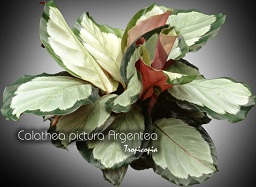Table of contents
Silver Calathea

Latin Name: Calathea pictura ‘Argentea’
Category: Foliage plant
Family: Marantaceae
Origin: Cultivar
Climate: Tropical
Growing Zones: 11
Care Instructions
The Silver Calathea (Calathea pictura ‘Argentea’) is a tropical plant that originates from Cultivar. This foliage plant plant belongs to the Marantaceae family and is well-suited for growing in USDA zones 11.
Complete Care Guide for Silver Calathea (Calathea pictura ‘Argentea’)
Watering Requirements
The Silver Calathea, known for its striking foliage, thrives in a humid environment and requires consistent watering to maintain its vibrant leaves. It is essential to keep the soil evenly moist but not soggy. Water the plant when the top inch of the soil feels dry to the touch. During the growing season (spring and summer), you may need to water more frequently, approximately once a week, while in the dormant season (fall and winter), reduce watering to every 10-14 days. Always use room temperature water, as cold water can shock the roots. Additionally, consider using distilled or rainwater, as Calatheas are sensitive to the chemicals found in tap water, which can lead to leaf browning.
Light Conditions
Silver Calathea prefers bright, indirect light to thrive. Direct sunlight can scorch its delicate leaves, leading to unsightly brown patches. Ideally, place your Calathea near a north or east-facing window where it can receive filtered light. If you notice the leaves losing their vibrant patterns or becoming leggy, it may be a sign that the plant is not receiving enough light. Conversely, if the leaves start curling or developing brown edges, it may be getting too much direct sunlight. In low-light conditions, the plant can survive, but its growth may slow down, and the leaf patterns may become less pronounced.
Soil Preferences
The ideal soil for Silver Calathea is a well-draining, rich potting mix that retains moisture without becoming waterlogged. A blend of peat moss, perlite, and orchid bark works well to provide the necessary aeration and drainage. Aim for a slightly acidic to neutral pH (around 6.0 to 7.0) for optimal growth. Regular fertilization is also crucial during the growing season; use a balanced, water-soluble fertilizer diluted to half strength every 4-6 weeks. Avoid fertilizing during the winter months when the plant is dormant, as this can lead to nutrient buildup and root burn.
Pests and Diseases
While Silver Calathea is relatively resilient, it can be susceptible to common houseplant pests such as spider mites, aphids, and mealybugs. Regularly inspect the undersides of the leaves for any signs of infestation. If you notice pests, treat the plant with insecticidal soap or neem oil, ensuring to cover all leaf surfaces. Additionally, Calatheas can suffer from leaf spot diseases, often caused by overwatering or poor air circulation. To prevent this, ensure proper watering practices and provide adequate humidity without waterlogging the soil. If leaf spots appear, remove affected leaves and adjust care accordingly.
Special Care Tips
To keep your Silver Calathea healthy and thriving, consider the following special care tips: Maintain high humidity levels (around 50-60%) by misting the leaves regularly or using a humidifier, especially in dry indoor environments. Grouping plants together can also help increase humidity. Rotate the plant occasionally to ensure even growth and prevent it from leaning towards the light source. Additionally, be mindful of temperature fluctuations; Calatheas prefer temperatures between 65°F to 80°F (18°C to 27°C) and should be kept away from drafts, heating vents, and air conditioning units. Lastly, repot your Calathea every couple of years to refresh the soil and provide more space for growth, ideally in the spring.








